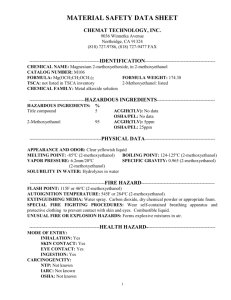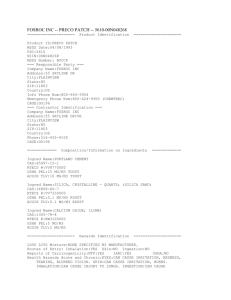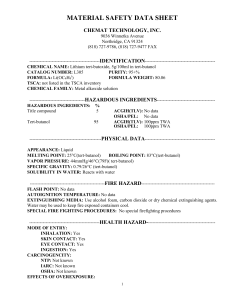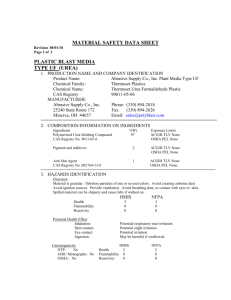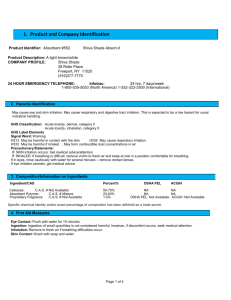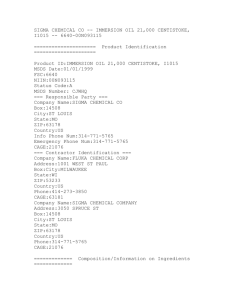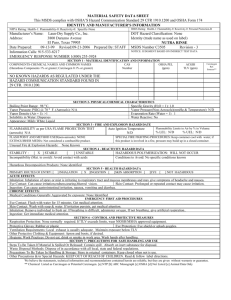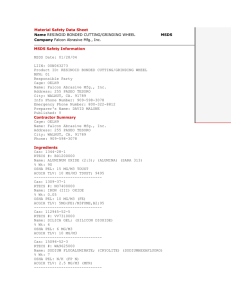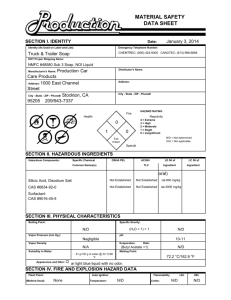Document - Chemat Scientific
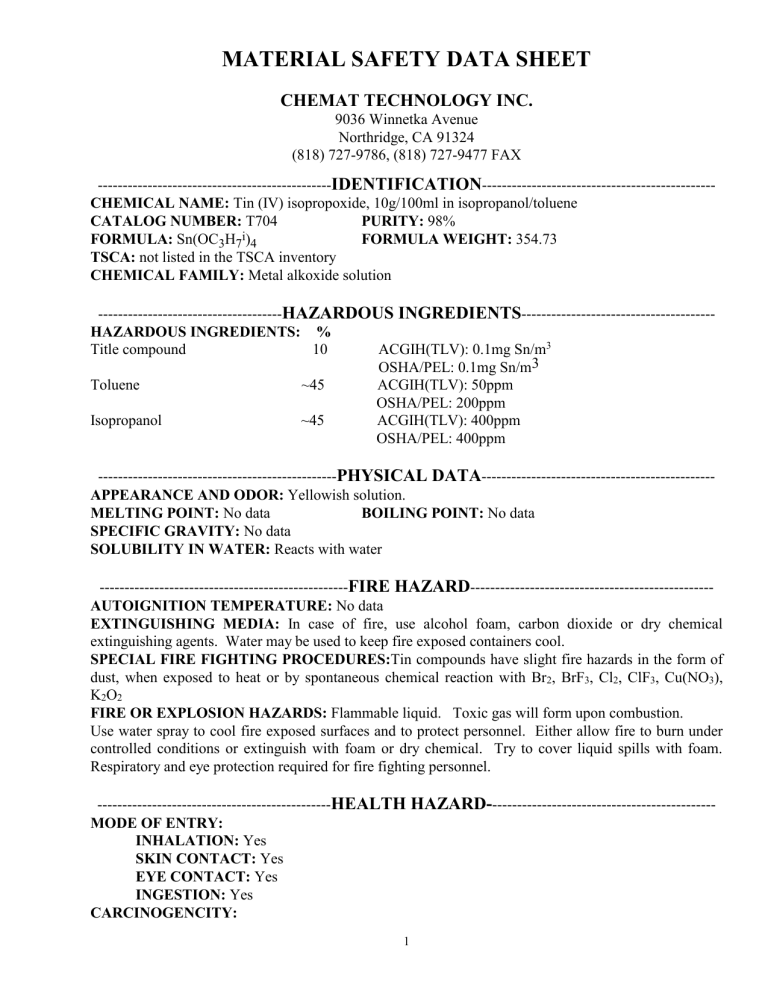
MATERIAL SAFETY DATA SHEET
CHEMAT TECHNOLOGY INC.
9036 Winnetka Avenue
Northridge, CA 91324
(818) 727-9786, (818) 727-9477 FAX
-----------------------------------------------
IDENTIFICATION
-----------------------------------------------
CHEMICAL NAME: Tin (IV) isopropoxide, 10g/100ml in isopropanol/toluene
CATALOG NUMBER: T704
FORMULA: Sn(OC
3
H
7 i
)
4
TSCA: not listed in the TSCA inventory
PURITY:
CHEMICAL FAMILY: Metal alkoxide solution
98%
FORMULA WEIGHT: 354.73
-------------------------------------
HAZARDOUS INGREDIENTS
---------------------------------------
HAZARDOUS INGREDIENTS: %
Title compound 10 ACGIH(TLV): 0.1mg Sn/m
3
OSHA/PEL: 0.1mg Sn/m3
Toluene ~45 ACGIH(TLV): 50ppm
OSHA/PEL: 200ppm
Isopropanol ~45 ACGIH(TLV): 400ppm
OSHA/PEL: 400ppm
------------------------------------------------
PHYSICAL DATA
-----------------------------------------------
APPEARANCE AND ODOR: Yellowish solution.
MELTING POINT: No data BOILING POINT: No data
SPECIFIC GRAVITY: No data
SOLUBILITY IN WATER: Reacts with water
--------------------------------------------------
FIRE HAZARD
-------------------------------------------------
AUTOIGNITION TEMPERATURE: No data
EXTINGUISHING MEDIA: In case of fire, use alcohol foam, carbon dioxide or dry chemical extinguishing agents. Water may be used to keep fire exposed containers cool.
SPECIAL FIRE FIGHTING PROCEDURES: Tin compounds have slight fire hazards in the form of dust, when exposed to heat or by spontaneous chemical reaction with Br
2
, BrF
3
, Cl
2
, ClF
3
, Cu(NO
3
),
K
2
O
2
FIRE OR EXPLOSION HAZARDS: Flammable liquid. Toxic gas will form upon combustion.
Use water spray to cool fire exposed surfaces and to protect personnel. Either allow fire to burn under controlled conditions or extinguish with foam or dry chemical. Try to cover liquid spills with foam.
Respiratory and eye protection required for fire fighting personnel.
-----------------------------------------------
HEALTH HAZARD-
---------------------------------------------
MODE OF ENTRY:
INHALATION: Yes
SKIN CONTACT: Yes
EYE CONTACT: Yes
INGESTION: Yes
CARCINOGENCITY:
1
NTP: Not known
IARC: Not known
OSHA: Not known
EFFECTS OF OVEREXPOSURE:
INHALATION: Tin compounds may be highly toxic and may produce central nervous system effects. May cause irritation of the nose and throat. Exposure to high concentrations has a narcotic effect, producing symptoms of drowsiness, headache, staggering, unconsciousness, and possibly death.
Alkyl tin compounds may be highly toxic and produce skin rashes. Dust of tin oxides have caused a pneumoconiosis, which is relatively benign.
High vapor concentrations are irritating to the eyes and the respiratory tract, may cause headaches, dizziness, anesthesia, drowsiness, unconsciousness, central nervous system effects, brain damage and possibly death.
SKIN CONTACT: Organic tin compounds are absorbed via the skin. May cause irritation with stinging and burning sensations.
Frequent or prolonged contact may irritate and cause dermatitis.
EYE CONTACT: Vapors may irritate the eyes. Splashes may cause severe irritation, possible corneal burns and eye damage.
INGESTION: Small amounts of this product aspirated into the respiratory system during ingestion or vomitting may cause mild to severe pulmonary injury, possibly progressing to death.
EMERGENCY AND FIRST AID PROCEDURES:
INHALATION: Remove the victim to fresh air and seek medical attention if coughing, shortness of breath or irritation persists.
SKIN CONTACT: Wash the affected area with soap and water for at least 5 minutes.
EYE CONTACT: Immediately flush eyes, including under eyelids, with large amounts of water for at least 15 minutes. Call a physician.
INGESTION: Give the victim plenty of water and seek immediate medical attention.
-----------------------------------------------
REACTIVITY DATA
--------------------------------------------
STABILITY: Moisture-sensitive material.
CONDITIONS TO AVOID: Contact with ignition source or heat.
INCOMPATIBILITY: Moisture, heat, strong oxidizers, acetaldehyde, chlorine, ethylene oxide, hydrogen-palladium combination, nitroform, phosgene, hydrogen peroxide-sulfuric acid combination, potassium tert-butoxide, hypochlorous acid, isocyanates, oleum, perchloric acid, aluminum isopropoxide, crotonaldehyde.
HAZARDOUS DECOMPOSITION PRODUCTS: CO, CO
2
, tin oxide, and organic fumes
HAZARDOUS POLYMERIZATION: None
---------------------------------
ENVIRONMENTAL INFORMATION
--------------------------------
SPILL OR LEAKAGE PROCEDURES: Wearing full protective equipment, eliminate all sources of ignition. Cover spill with dry sand or vermiculite. Sweep up the mixture and dispose of properly.
WASTE DISPOSAL: Consult state, local, or federal EPA regulations for proper disposal.
----------------------------------
PROTECTION AND PRECAUTIONS
--------------------------------
VENTILATION REQUIREMENTS: Glove bag or box with dry, inert atmosphere.
RESPIRATORY PROTECTION: NIOSH/MSHA approved respirator with an organic vapor cartridge.
PROTECTIVE GLOVES: Rubber
EYE/FACE PROTECTION: ANSI approved safety goggles
HANDLING AND STORAGE: Handle and store the material under an inert atmosphere of nitrogen or argon. Keep away from heat.
2
OTHER PRECAUTIONS: The material will react with air and moisture. Lab coat and apron, flame and chemical resistant coveralls, eyewash capable of sustained flushing, safety drench shower and hygienic facilities for washing.
---------------------------------------------------------------------------------------------------------------------------
The information herein is believed to be accurate and reliable as of the date compiled. However, Chemat Technology Inc. makes no representation, warranty or guarantee of any kind with respect to the information on this data sheet or any use of the product based upon this information.
DATE PREPARED: June 13, 2005
3
